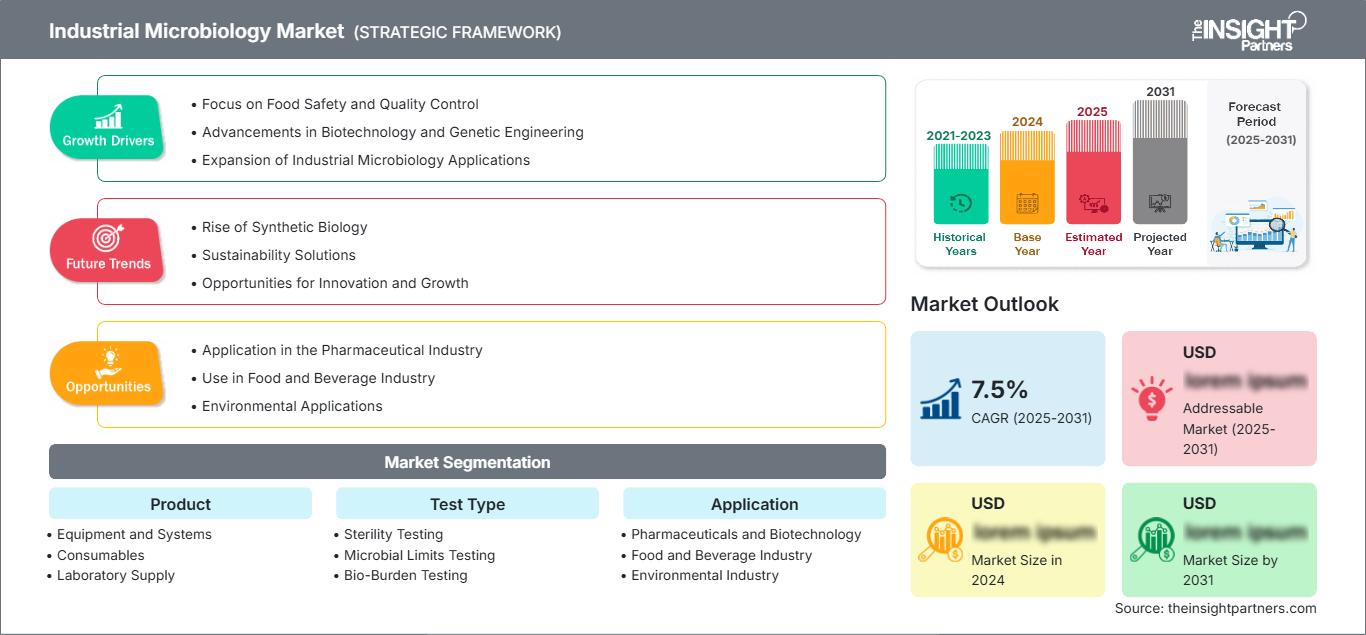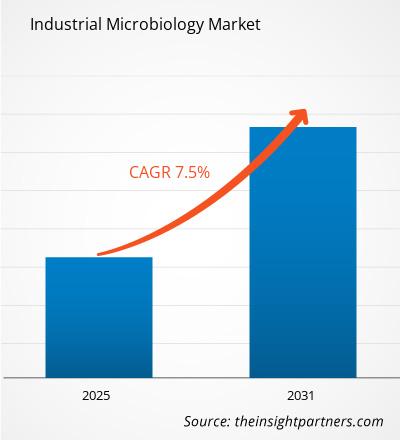Le marché de la microbiologie industrielle devrait atteindre 25,88 milliards de dollars américains d'ici 2031. Il devrait enregistrer un TCAC de 6,8 % entre 2025 et 2031.
La microbiologie industrielle est l'un des domaines à la croissance la plus rapide. Elle exploite la capacité des micro-organismes à produire une vaste gamme de produits et de services. Une étude de marché sur le marché mondial de la microbiologie industrielle est proposée afin d'offrir une analyse complète des données actuelles, des tendances à venir et de ses principaux moteurs. Ce rapport couvre plusieurs aspects du marché, notamment sa taille, son taux de croissance, sa segmentation par type de produit, application et région, ainsi qu'une analyse approfondie du paysage concurrentiel. Ce rapport vise à fournir un aperçu du marché de la microbiologie industrielle et à offrir aux fabricants, fournisseurs, distributeurs, établissements de recherche et investisseurs des informations utiles pour prendre des décisions éclairées et tirer parti des opportunités de croissance rapide de ce marché.
Objectif du rapport
Le rapport « Marché de la microbiologie industrielle » de The Insight Partners a pour objectif de décrire le paysage actuel et la croissance future, les principaux facteurs de croissance, les défis et les opportunités. Il fournira des informations précieuses à divers acteurs du secteur, tels que :
- Fournisseurs de technologies/Fabricants : Pour comprendre l’évolution de la dynamique du marché et connaître les opportunités de croissance potentielles, afin de prendre des décisions stratégiques éclairées.
- Investisseurs : Pour réaliser une analyse approfondie des tendances concernant le taux de croissance du marché, les projections financières et les opportunités tout au long de la chaîne de valeur.
- Organismes de réglementation : Pour encadrer les politiques et les activités du marché afin de minimiser les abus, préserver la confiance des investisseurs et garantir l’intégrité et la stabilité du marché.
Segmentation du marché de la microbiologie industrielle : Produits
- Équipements et systèmes
- Consommables
- Fournitures de laboratoire
Type de test
- Tests de stérilité
- Tests de limites microbiennes
- Tests de charge microbienne
- Tests d'eau et d'environnement
Application
- Industrie pharmaceutique et biotechnologique
- Industrie agroalimentaire
- Industrie environnementale
- Industrie agricole
Répartition géographique
- Amérique du Nord
- Europe
- Asie-Pacifique
- Amérique du Sud et centrale
- Moyen-Orient et Afrique
Vous bénéficierez d’une personnalisation sur n’importe quel rapport - gratuitement - y compris des parties de ce rapport, ou une analyse au niveau du pays, un pack de données Excel, ainsi que de profiter d’offres exceptionnelles et de réductions pour les start-ups et les universités
Marché de la microbiologie industrielle: Perspectives stratégiques

-
Obtenez les principales tendances clés du marché de ce rapport.Cet échantillon GRATUIT comprendra une analyse de données, allant des tendances du marché aux estimations et prévisions.
Facteurs de croissance du marché de la microbiologie industrielle
- Priorité à la sécurité et au contrôle de la qualité des aliments : L’importance croissante accordée à la sécurité et au contrôle de la qualité des aliments a renforcé le rôle crucial des tests et analyses microbiologiques dans la prévention des mésusages alimentaires, stimulant ainsi les applications de la microbiologie industrielle.
- Progrès en biotechnologie et en génie génétique : Les innovations en biotechnologie et en génie génétique ouvrent de nouveaux champs d’application en microbiologie industrielle, permettant le développement de nouveaux produits et procédés.
- Expansion des applications de la microbiologie industrielle : Ces développements élargissent le champ d’application de la microbiologie industrielle, la positionnant comme un outil essentiel pour le développement de nouveaux produits et l’optimisation des procédés.
Tendances futures du marché de la microbiologie industrielle
- Essaut de la biologie synthétique : La biologie synthétique, qui consiste à modifier génétiquement des micro-organismes pour produire de nouveaux composés et biocarburants, transforme des secteurs tels que la pharmacie, la chimie et l’énergie, façonnant ainsi l’avenir de la microbiologie industrielle.
- Solutions de développement durable : La microbiologie industrielle offre des solutions aux défis environnementaux, notamment la gestion des déchets, la bioremédiation et la capture du carbone, positionnant ainsi le secteur comme un acteur clé des efforts de développement durable.
- Opportunités d’innovation et de croissance : Le marché de la microbiologie industrielle recèle un vaste potentiel d’innovation et de croissance, porté par les tendances émergentes en biologie synthétique, en médecine personnalisée et en développement durable.
Opportunités du marché de la microbiologie industrielle
- Applications dans l’industrie pharmaceutique : La microbiologie industrielle joue un rôle essentiel dans l’industrie pharmaceutique, permettant la découverte de nouveaux antibiotiques, vaccins et produits biothérapeutiques.
- Utilisations dans l’industrie agroalimentaire : Les technologies microbiennes sont utilisées dans la production d’aliments fermentés, de boissons et d’additifs alimentaires, stimulant l’innovation et la croissance dans le secteur alimentaire.
- Applications environnementales : La microbiologie industrielle contribue à la bioremédiation, au traitement des déchets et à la production de bioénergie, aidant ainsi à relever les défis environnementaux grâce à des solutions microbiennes.
Marché de la microbiologie industrielle
Les analystes de The Insight Partners ont analysé en détail les tendances régionales et les facteurs influençant le marché de la microbiologie industrielle tout au long de la période prévisionnelle. Cette section aborde également les segments et la répartition géographique du marché de la gestion des troubles du rythme cardiaque en Amérique du Nord, en Europe, en Asie-Pacifique, au Moyen-Orient et en Afrique, ainsi qu'en Amérique du Sud et centrale.
Portée du rapport sur le marché de la microbiologie industrielle
| Attribut de rapport | Détails |
|---|---|
| Taille du marché en 2024 | US$ XX Billion |
| Taille du marché par 2031 | US$ 25.88 Billion |
| TCAC mondial (2025 - 2031) | 6.8% |
| Données historiques | 2021-2023 |
| Période de prévision | 2025-2031 |
| Segments couverts |
By Produit
|
| Régions et pays couverts |
Amérique du Nord
|
| Leaders du marché et profils d'entreprises clés |
|
Densité des acteurs du marché de la microbiologie industrielle : comprendre son impact sur la dynamique commerciale
Le marché de la microbiologie industrielle connaît une croissance rapide, portée par une demande croissante des utilisateurs finaux, elle-même alimentée par l'évolution des préférences des consommateurs, les progrès technologiques et une meilleure connaissance des avantages du produit. Face à cette demande grandissante, les entreprises élargissent leur offre, innovent pour répondre aux besoins des consommateurs et tirent parti des tendances émergentes, ce qui stimule davantage la croissance du marché.

- Obtenez le Marché de la microbiologie industrielle Aperçu des principaux acteurs clés
Points clés de la vente
- Couverture exhaustive : Ce rapport analyse en détail les produits, services, types et utilisateurs finaux du marché de la microbiologie industrielle, offrant ainsi une vision globale.
- Analyse d'experts : Ce rapport repose sur une connaissance approfondie du secteur et des analystes.
- Informations actualisées : Grâce à sa couverture des informations et tendances les plus récentes, ce rapport garantit la pertinence des données pour les entreprises.
- Options de personnalisation : Ce rapport peut être personnalisé pour répondre aux besoins spécifiques des clients et s'adapter parfaitement à leurs stratégies commerciales.
Ce rapport d'étude de marché sur la microbiologie industrielle peut donc contribuer à décrypter et comprendre le contexte sectoriel et les perspectives de croissance. Malgré quelques points à améliorer, les avantages globaux de ce rapport tendent à surpasser ses inconvénients.
- Analyse historique (2 ans), année de base, prévision (7 ans) avec TCAC
- Analyse PEST et SWOT
- Taille du marché Valeur / Volume - Mondial, Régional, Pays
- Industrie et paysage concurrentiel
- Ensemble de données Excel
Rapports récents
Rapports connexes
Témoignages
Raison d'acheter
- Prise de décision éclairée
- Compréhension de la dynamique du marché
- Analyse concurrentielle
- Connaissances clients
- Prévisions de marché
- Atténuation des risques
- Planification stratégique
- Justification des investissements
- Identification des marchés émergents
- Amélioration des stratégies marketing
- Amélioration de l'efficacité opérationnelle
- Alignement sur les tendances réglementaires






















 Obtenez un échantillon gratuit pour - Marché de la microbiologie industrielle
Obtenez un échantillon gratuit pour - Marché de la microbiologie industrielle